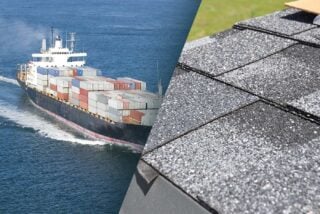
In October, Canada’s government followed through on a promise it made in 2016 to eventually ban asbestos use. On December 30, the Prohibition of Asbestos and Products Containing Asbestos Regulations will prevent the sale and use of asbestos, but will also target the sale, importation, and use of asbestos-containing products.
Facing mounting pressure from environmental and health advocacy groups, the regulation has largely put an end to asbestos use in the country, though critics have been quick to point out that several exceptions have been made to allow for some applications. For example, asbestos-containing products may still be used to service and repair military equipment and equipment in nuclear facilities until 2023. An exclusion has also been made for the chlor-alkali industry, where asbestos use won’t be prohibited until 2030. In the United States, the chlor-alkali industry is the main importer of raw asbestos and accounted for almost all asbestos use in 2017.
Canada’s push to ban asbestos was nearly unheard of as recently as a decade ago. For years, the Canadian government blocked efforts to add asbestos to the Rotterdam Convention’s hazardous substances list. But in 2011, the last asbestos mining operation in Canada shut down, and the country vowed not to block asbestos from being added to the international treaty the following year. In May 2016, Prime Minister Justin Trudeau said the country would push forward with its own ban of the toxic chemical.
While Canada is far from the first country to cut ties with the cancer-causing mineral, it joins a growing list of countries putting public safety first. The European Union prohibited asbestos use back in 2005, and Australia banned all types of asbestos materials and uses in 2003. Even Brazil, once a major exporter of asbestos to the U.S., decided in late 2017 to ban asbestos production and use.
An End to Mesothelioma in the Netherlands
In countries where asbestos use has been banned for decades, the fight has moved from asbestos production to abatement. The Netherlands ended asbestos use in 1993, but the European country recently decided to enforce a regulation requiring all asbestos roofing in the country to be removed by 2024.
According to BME Opleidingen, an estimated 70% of all buildings in the country contain asbestos somewhere. Though the cost is high, thought to be about 1.5 billion euros, the government is committed to the project and is offering subsidies for qualifying people, including those replacing old asbestos roofing with solar panels and those who have to remove more than 35 square meters (about 376 square feet) of asbestos. These moves and subsequent dollars are all part of an attempt by the Netherlands to eliminate all asbestos-related deaths by the year 2040.
A Continuing Danger at Home
As other countries continue to ban asbestos and work to remove its dangers, use of the toxin is seemingly on the rise in the United States. According to an analysis performed by the Asbestos Disease Awareness Organization (ADAO) and the Environmental Working Group (EWG), asbestos imports rose from 13 metric tons in July to 272 metric tons in August, an increase of more than 2,000%.
It’s difficult to say what caused the spike in American imports, but the rise came soon after an announcement was made by the government’s environmental watchdog agency. In June, the Environmental Protection Agency proposed a suggested new use rule, or SNUR, that would require manufacturers and importers to receive EPA approval before starting or resuming certain applications of the mineral.
Interestingly, all of the asbestos imported into the U.S. this year has come from Brazil, which is working through its stockpiles after banning production and use last year. When that supply is drained, U.S. importers will only have Russia, Kazakhstan, and China left as the world’s suppliers.
The controversy has grown in recent years as President Trump has gone on the record several times to defend asbestos use in buildings, and has even said that calls to end asbestos use were led by “the mob.” The president’s words, however, may have embolden Russia’s own asbestos manufacturers. Earlier this summer, an asbestos producer in Russia began to send out its products with a seal bearing Trump’s face along with the phrase, “Approved by Donald Trump, 45th President of the United States.”
Meanwhile, research data from the Asbestos Disease Awareness Organization (ADAO) and the International Commission of Occupational Health reported earlier this year that asbestos may be linked to nearly 40,000 deaths annually in the United States, including more than 3,100 from mesothelioma. This statistic is more than double what previous reporting has suggested and contradicts the government’s own published numbers, further stressing the importance of a worldwide asbestos ban.




